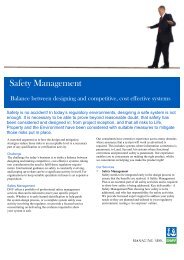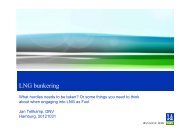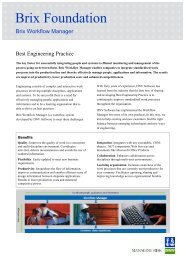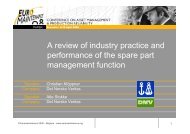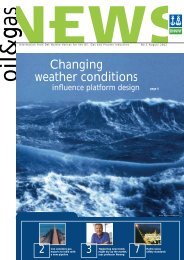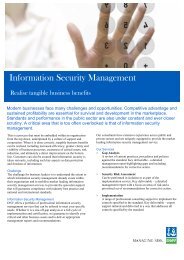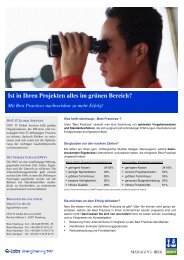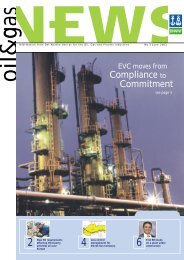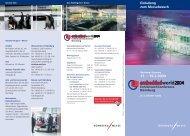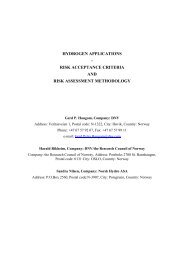The container ship ontainer ship ontainer ship - its ... - DNV Germany
The container ship ontainer ship ontainer ship - its ... - DNV Germany
The container ship ontainer ship ontainer ship - its ... - DNV Germany
You also want an ePaper? Increase the reach of your titles
YUMPU automatically turns print PDFs into web optimized ePapers that Google loves.
<strong>The</strong> <strong>The</strong> <strong>c<strong>ontainer</strong></strong> <strong>ontainer</strong> <strong>ship</strong> - <strong>its</strong> chances and challenges<br />
A A A revolution revolution revolution of of of global global global transportation<br />
transportation- transportation and and a a look look into into the the future future<br />
PART ART THREE THREE: THREE<br />
Ships Ships in in Operation<br />
Operation<br />
by by Frank Frank Hensel, Hensel, Hensel, <strong>DNV</strong> <strong>DNV</strong> <strong>Germany</strong><br />
<strong>Germany</strong><br />
Introduction<br />
Introduction:<br />
Introduction<br />
Owners, managers and operators of the worldwide <strong>c<strong>ontainer</strong></strong> <strong>ship</strong> fleet are<br />
today facing a number of significant challenges. <strong>The</strong> oversupply of tonnage<br />
in almost all segments, low freight and charter rates and, not least, high<br />
fuel oil prices have put the <strong>ship</strong>ping market under a lot of pressure.<br />
As a consequence, these aspects are causing all those in the industry to<br />
have a high cost awareness regarding the entire scope of service levels.<br />
<strong>The</strong> lines are reorganising their service frequencies to suit market<br />
requirements. Charter periods are quite short and rates are down to opex<br />
or even below. Operators have higher demands and owners are<br />
endeavouring to keep their vessels in service.<br />
Fuel efficiency is of course at the top of the agenda and a vessel’s speed<br />
and consumption ratio are one of the main topics when a <strong>ship</strong> is being<br />
considered for a new charter.<br />
Owners are putting a lot of effort into this area in order to comprehensively<br />
document their vessels’ performance.<br />
In addition to administrative requirements that are forcing investments to<br />
meet the new emissions limitations, tighter rules for the treatment of ballast<br />
water will also have to be complied with in the near future.<br />
Further administrative requirements are in the pipeline. <strong>The</strong> onboard <strong>ship</strong><br />
efficiency management plan will be compulsory very soon and more and<br />
more flag states are ratifying the MLC2006.
Keeping operational costs under control<br />
- Fuel cost<br />
In a prevailing market with very low freight rates, both liner operators and<br />
charter owners are showing special awareness of cost reductions and/or<br />
control. Ship operators are suffering from low charter rates and<br />
unemployed tonnage, while fuel saving measures are number one on the<br />
agenda for all of them. As the fuel oil price has again reached 750 USD/t<br />
and is continuing to rise, these measures are essential to keep a vessel in<br />
service. During the last crisis, slow steaming had already successfully<br />
been introduced and proved that fuel and thus expenses could be saved<br />
and tonnage could be kept in service. However, fuel efficiency can be<br />
further improved.<br />
<strong>The</strong> »<strong>DNV</strong> Fuel Saving Guideline - For C<strong>ontainer</strong> Ships«, published in<br />
2011 and issued together with HSVA, provides impartial expert advice on<br />
available technology and the cost effectiveness of fuel-saving measures<br />
which are relevant for <strong>c<strong>ontainer</strong></strong> <strong>ship</strong>s. Besides many design features to be<br />
considered, especially for newbuildings, the guideline also provides an<br />
overview of operational measures to save fuel.<br />
For a lot of measures the initial <strong>ship</strong> design is of course crucial. However,<br />
there is also a big potential on the operational side. Thus both the fuel<br />
efficiency of <strong>ship</strong> operations and the fleet management should be<br />
evaluated. If the fleet management side in <strong>ship</strong>ping companies has already<br />
been successfully optimised during the past decade, the main potential in<br />
the running fleet lies in most cases in fuel saving operations.<br />
Key topics here are:<br />
- Main energy consumers - tuning and efficiency<br />
- Speed optimisation and voyage planning<br />
- Trim and draft optimisation<br />
- Bunkering strategy and procedures and fuel quality monitoring<br />
- Ship performance and operational procedures<br />
Especially performance monitoring and trim/draft optimisation should be<br />
subject to a more in-depth evaluation as innovative tools are available and<br />
the investments are comparatively reasonable even in hard times.<br />
Vessel Performance Monitoring & Benchmarking<br />
- Voyage execution and the related possible savings are often<br />
underrated<br />
In order to assess the present performance status, measures must be<br />
applied that enable the operator to act and possibly change certain<br />
parameters. This includes proper data collection on board and regular<br />
performance reports (e.g. daily at noontime) to be sent to owners, which<br />
should have centralised data storage for their entire fleet. Easy, uniform<br />
and reliable data transfer from <strong>ship</strong> to shore is therefore necessary.
<strong>The</strong> shore staff must follow this up closely and give case-by-case feedback<br />
to the <strong>ship</strong>’s command. Data processing has to provide the ability to<br />
compare and benchmark the whole fleet. This initiates a certain<br />
competition amongst vessels. Efficient KPIs and an efficient reporting<br />
scheme also mean the management can be told to act affirmatively.<br />
<strong>DNV</strong> supports the setting-up of reporting and benchmarking software or<br />
the enhancement of the functionality of existing reporting software. This<br />
enables a shared workload and commitment to success. As a direct followup<br />
of the vessel’s performance (noon reports or special performance<br />
reports), off-spec performance can be intuitively reported (traffic light). <strong>The</strong><br />
necessary calculations are based on state-of-the-art numerical methods<br />
and will be tailored to available data. <strong>The</strong> documentation helps to avoid<br />
costly discussions about speed/consumption claims.<br />
Asset Asset Asset Management<br />
Management<br />
Management<br />
- Maximum possible time in service<br />
During times when charter rates are under pressure, it is essential to keep<br />
the vessel in service for as many days as possible. Today, some owners<br />
already go for an extended dry docking interval of 7.5 years. In order to<br />
benefit from this and permanently monitor the vessels’ condition, company<br />
maintenance systems have been installed. An operational hull planned<br />
maintenance system improves the asset management and provides more<br />
predictable maintenance costs. Close cooperation with the classification<br />
society makes the situation even more beneficial. Frequent inspections<br />
mean that potential problems may be discovered at an early stage. <strong>The</strong><br />
inspections can be carried out when time allows and compartments are<br />
available. Trained seagoing officers with well-established programmes and<br />
visual inspection manuals can conduct the inspections during long sea<br />
passages. A working record-keeping system containing photographs and<br />
acceptance criteria is a necessary feature. Good record-keeping and<br />
documentation on board empowers the personnel to take responsibility.<br />
<strong>The</strong> management office keeps the cross-fleet overview, revealing fleet<br />
trends and sister <strong>ship</strong> experience.<br />
Hull PMS<br />
- A modern survey scheme<br />
<strong>The</strong> <strong>DNV</strong> Hull PMS (planned maintenance system) puts the surveyor in a<br />
position to evaluate the results of inspections carried out by <strong>ship</strong> crew<br />
and/or shore personnel and reported in the PMS. Such inspections can be<br />
waived provided the attending surveyor is satisfied that the condition<br />
complies with the Rules.<br />
- Areas of Attention
Inspectors need to know what they are looking for. <strong>DNV</strong> has experience of<br />
<strong>ship</strong>s built to all class standards through class transfers of <strong>ship</strong>s built to<br />
other class societies’ standards. Typical defects and critical areas are<br />
identified and updated and included in an inspection manual, thus<br />
providing guidance to inspectors. Side shell fatigue can be an issue on<br />
older <strong>c<strong>ontainer</strong></strong> <strong>ship</strong>s. Fatigue cracks develop over time, depending on the<br />
design details and <strong>ship</strong> operations. <strong>The</strong> expected fatigue life can be<br />
calculated and provide guidance on inspection frequency.<br />
<strong>The</strong> timely discovery of fatigue cracks will reduce the risk of more<br />
comprehensive repairs and unscheduled off hire. <strong>The</strong> cracks can be<br />
repaired by fitting brackets according to calculated design modifications. A<br />
<strong>ship</strong> with side shell fatigue crack problems was transferred to <strong>DNV</strong> class<br />
about 4½ years after delivery, before <strong>its</strong> first class renewal survey. <strong>The</strong><br />
problem was minimised as the class society and manager had cooperated<br />
on a hull PMS system, with class being involved at once in providing a<br />
solution. Two well known <strong>c<strong>ontainer</strong></strong> <strong>ship</strong> managers have operated hull PMS<br />
pilot schemes in cooperation with <strong>DNV</strong> for more than five years now. <strong>The</strong><br />
new survey arrangement is based on and incorporates this experience.<br />
Fully fledged IT-based reporting and maintenance tools are available from<br />
<strong>DNV</strong> but are not a prerequisite for the Hull PMS survey arrangement. A<br />
simplified spreadsheet reporting tool is available and is being successfully<br />
used by managers. This may serve as a starting point for companies that<br />
are new to hull planned maintenance systems or have their own systems<br />
in place already.<br />
<strong>The</strong> first pilot projects with German customers will start soon.<br />
Admi Adminis Admi Admi is istrative is trative requirements requirements and and changes<br />
changes<br />
<strong>The</strong> following administrative requirements/changes are the most important<br />
for the <strong>c<strong>ontainer</strong></strong> <strong>ship</strong> fleet in operation:<br />
- IMO/ ECA<br />
- Ballast water<br />
- MLC2006<br />
- SEEMP<br />
Upcoming regulative changes related to emissions to air have been<br />
discussed earlier and the <strong>ship</strong>ping companies are well aware of these, so<br />
we do not deem it necessary to discuss them in more detail here.<br />
A very important change and real challenge are envisaged when the<br />
Ballast Water Convention comes into force. This will be 12 months after it<br />
is ratified by more than 30 states representing 35% of the world fleet. As<br />
more than 30 states have already ratified it, the <strong>ship</strong>ping world is now<br />
(status: March 2012) 8.56% of the world fleet away from the entry into<br />
force of the convention. This could take place very quickly, as Panama<br />
alone could bring in the missing capacity.<br />
<strong>The</strong> big challenge will be to retrofit all the vessels between 2015 and 2020.<br />
<strong>The</strong> availability of systems, detailed technical features including type
approvals, etc, and last but not least the investment volumes have to be<br />
clarified soon if <strong>ship</strong>s are to be ready.<br />
MLC2006 has been ratified by more 22 countries with more than 55% of<br />
the world tonnage. Eight countries are still missing and the convention will<br />
enter into force for all <strong>ship</strong>s above 500gt from »MLC countries« or trading<br />
in »MLC ports«. This is also expected to happen soon and the <strong>ship</strong>ping<br />
industry has to be well prepared for this too.<br />
SEEMP - Ship Energy Efficiency Management Plan<br />
- Another regulation soon to be mandatory:<br />
<strong>The</strong> most relevant requirement is the introduction of the SEEMP.<br />
<strong>The</strong> SEEMP was adopted at the MEPC 62nd session in July 2011, under<br />
mounting pressure from the industry and authorities, and will become<br />
mandatory for all vessels at their first renewal or intermediary survey after<br />
1 January 2013.<br />
SEEMP - what exactly is it?<br />
IMO - MEPC.1/683 Guidance for the Development of a SEEMP recognises<br />
that operational efficiencies will make an invaluable contribution to<br />
reducing global carbon emissions. <strong>The</strong> SEEMP’s main purpose is to<br />
establish a mechanism for a company and/or <strong>ship</strong> to improve the energy<br />
efficiency of the <strong>ship</strong>’s operation that is preferably linked to a broader<br />
corporate energy management policy. <strong>The</strong> SEEMP is to be customised to<br />
suit the characteristics and needs of individual companies and <strong>ship</strong>s. <strong>The</strong><br />
IMO guideline <strong>its</strong>elf can be found at the IMO website www.imo.org.<br />
Please note that this will be updated over the coming 12 months or more,<br />
and whilst it is not expected to change too much, it will be modified. Always<br />
check the IMO website for the latest version.<br />
Going beyond compliance<br />
<strong>The</strong> IMO Guidance for the development of a SEEMP for <strong>ship</strong> owners and<br />
operators is acknowledged and fully supported. <strong>The</strong> key difference in the<br />
outcome will be in <strong>its</strong> implementation. Developed SEEMPs are available<br />
for customers around the world with a systematic, structured and cost<br />
effective approach to each project. And as the overriding goal of having a<br />
SEEMP is to use less fuel (relatively speaking), the outcome of a<br />
successfully deployed SEEMP is reduced maintenance costs, lower<br />
running hours and fewer emissions. »To realise the benef<strong>its</strong>, you must first<br />
have a plan«. <strong>The</strong> <strong>DNV</strong> approach remains fully compliant with the IMO<br />
guidance and builds on it further by placing emphasis on the delivery and<br />
implementation of the plan. By drawing on insight into leading practices in<br />
a range of <strong>ship</strong>ping segments, class brings applied and practical<br />
intelligence to the SEEMP development process in order to ensure the<br />
<strong>ship</strong> owner or operator has the best possible chance of not only achieving<br />
compliance but also reaping the benef<strong>its</strong> of lower consumption and costs.
Four steps to success<br />
Step 1<br />
– Establish a baseline<br />
It is important to examine data, tools and processes in<br />
order to determine a credible baseline from which goals,<br />
plans and actions all grow.<br />
Step 2<br />
– Identify improvement potential<br />
Identify how much you can save and, just as importantly,<br />
what initiatives you need to undertake to realise the<br />
improvements.<br />
Step 3<br />
– Implement and monitor<br />
Put the plan into action and track performance using a<br />
variety of established systems/processes to help<br />
overcome resistance to ‘new’ initiatives.<br />
Step 4<br />
– Evaluate and update<br />
<strong>The</strong> progress of the different improvement initiatives<br />
should be regularly followed up by the responsible<br />
persons/department, and the<br />
performance assessment should be used to modify future goals and<br />
implementation tactics.<br />
Summary Summary: Summary<br />
Ship operators and managers must reduce and control their operational<br />
costs. Comprehensive tools are available for this purpose or can be<br />
developed individually. In future, competitiveness will be defined by fuel<br />
consumption and <strong>its</strong> dependable recording.<br />
PMS systems help to ensure dependable <strong>ship</strong> operations and allow<br />
improved planning in order to avoid expensive and inefficient off-hire.<br />
In order to cope with expected new regulations in future, <strong>ship</strong> operators<br />
must closely cooperate with the supply industry as well as with<br />
classification societies.<br />
With <strong>its</strong> long experience and expertise, reliable tools and individually<br />
adapted consultancy services, <strong>DNV</strong> is well prepared to assist the maritime<br />
industry.




